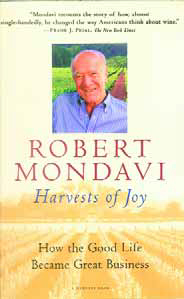Reharvesting Joy

It’s amazing for me to learn that this 100th issue of WaterShapes is carrying my 80th “Book Notes” column. It’s been a wonderful and fascinating experience – and as my wife puts it, has provided a great way to rationalize my literary addiction.
I remember when Eric Herman and I first discussed the idea for this column: At the time, we both wondered how long it could be sustained. After the best part of seven years, I think we’re both comfortable with the thought that it’s basically a journey without end.
To mark this special occasion, I want to look back at one of the most significant of all the books I’ve ever reviewed – one that isn’t about watershaping, construction, landscape architecture or anything in any way related to our industry. That book, which I wrote about way back in February 2003, is Harvests of Joy: How the Good Life Became Great Business by Robert Mondavi (with Paul Chutkow; Harcourt Brace, 1998).
I’d read it based on Brian Van Bower’s argument in his first WaterShapes column that Mondavi’s story offered a powerful parallel to what he saw as being needed by our industry. I’d read it more than once before reviewing it here and have returned to its inspiring pages many times since.
Brian’s discussion in February 1999 was as prophetic as it was profound: When Mondavi entered the winemaking business in the mid-1960s, U.S. vintners were focused on volume production and as a consequence made wines that paled in comparison to those made in Europe, where winemaking had long been considered an art form. Mondavi saw an opportunity to redefine winemaking with an emphasis on quality – and for a good, long time, people thought he was crazy.
Undeterred, Mondavi stuck to his vision, utterly revolutionized his industry and almost single-handedly created a marketplace in which winemakers in California’s Napa Valley and elsewhere across the state produce truly world-class wines.
It’s a great story that in many ways charts the changes we’ve seen in watershaping through the past decade, and I believe this magazine’s 100 issues have played a huge role in encouraging that transformation. I remember seeing my first copy of WaterShapes and understanding even then that it was onto something distinctive and significant: From the start, in fact, it has embodied a value system that has in ten years helped us all come to see the best watershapes as works of art rather than mere commodities.
I appreciated what I saw because it fell directly in line with what I was trying to do in my own career. All of a sudden, the magazine connected me with like-minded professionals on the same path, forging a community of watershapers who wanted to do more than make money on volume work and instead were trying to harvest the joy that comes from doing work that’s very special and creative.
For my part, writing this column has been a modest way to contribute to this evolution, and I hope that by sharing my own personal journey and the books I’ve loved to read, I’ve helped others gain access to information about places we may never see in person and explore ideas and disciplines that stand to help us improve what we do.
I’ve always believed that success, in this or any other field, is best achieved when we strive to improve our knowledge and broaden our horizons. WaterShapes has always been a vehicle for that process of betterment, and I’m proud to be a spoke in its wheel. Looking back through these ten years, I can only believe that Robert Mondavi would appreciate what we’ve all been trying to accomplish. Who knows? Perhaps he might even be encouraged enough to raise a glass to salute the effort.
Mike Farley is a landscape architect with more than 20 years of experience and is currently a designer/project manager for Claffey Pools in Southlake, Texas. A graduate of Genesis 3’s Level I Design School, he holds a degree in landscape architecture from Texas Tech University and has worked as a watershaper in both California and Texas.










